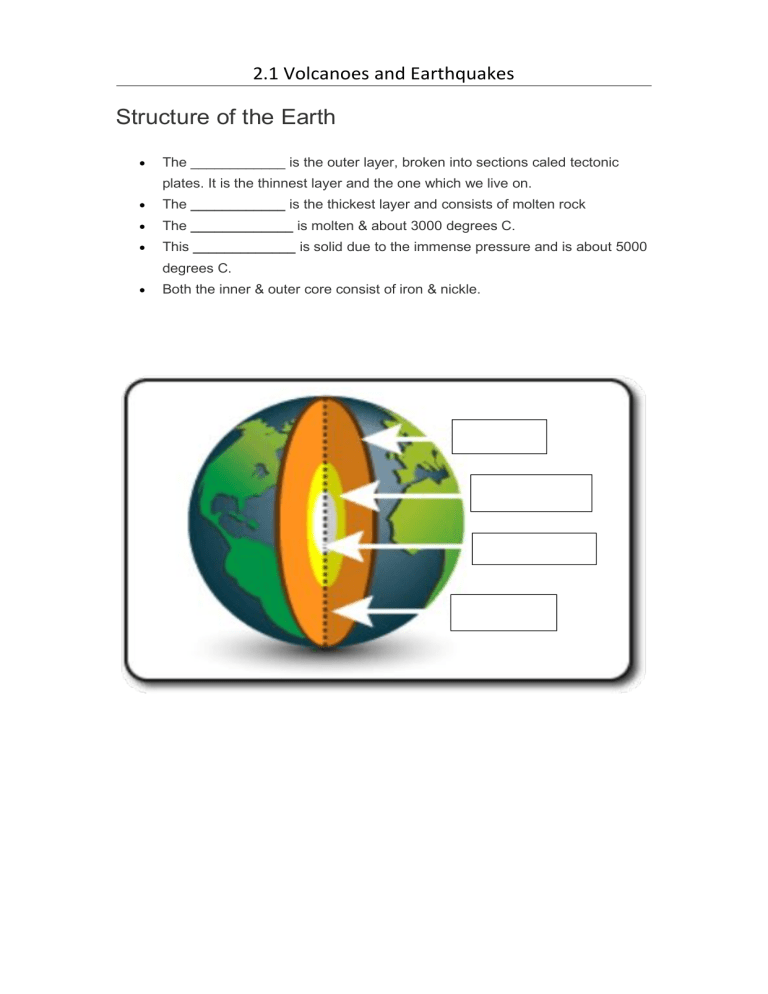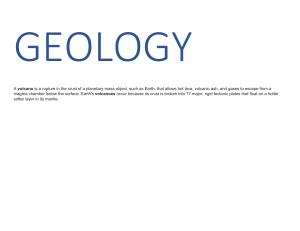
2.1 Volcanoes and Earthquakes Structure of the Earth The ____________ is the outer layer, broken into sections caled tectonic plates. It is the thinnest layer and the one which we live on. The ____________ is the thickest layer and consists of molten rock The _____________ is molten & about 3000 degrees C. This _____________ is solid due to the immense pressure and is about 5000 degrees C. Both the inner & outer core consist of iron & nickle. 2.1 Volcanoes and Earthquakes Plate movement The earths crust is broken into different sections which are slowly moving about. Collision boundary A plate boundary where two plates are converging. These include destructive boundaries, where an oceanic plate meets a continental plate, and collision boundaries, where the two plates are both continental plates. Constructive plate boundary A plate boundary where new material is being formed by the upwelling of magma from within the Earth’s interior. Conservative plate Where two plates slide past one boundary (or transform another without loss of plate boundary) material. Destructive plate Plate boundary where an boundary oceanic plate meets a continental plate. The oceanic plate is more dense than the continental plate, so it sinks below the continental crust. Subduction zone The area where one tectonic plate slides beneath another, a process known as subduction. One plate (usually a dense oceanic plate) plunges underneath a less dense continental plate. As it sinks, it melts and is destroyed, forming magma, which in turn may reach the surface through volcanic activity. 2.1 Volcanoes and Earthquakes Volcano A cone-shaped mountain formed by material (magma, ash and cinders) erupted from below the Earth’s surface. A volcano currently showing signs of activity. A volcano that has not erupted for a very long time but could erupt again. A volcano that has shown no signs of volcanic activity in historic times. Very fine-grained volcanic material. Molten magma that has reached the Earth’s surface. It may be liquid or may have solidified. Molten rock within the Earth. When magma reaches the surface it is called lava. The reservoir of magma located deep inside a volcano. Lava Extinct volcano Magma Ash Volcano Chamber Dormant volcano Active volcano 2.1 Volcanoes and Earthquakes Steep volcano formed of sticky (viscous) acidic lava, ash and cinders. A gentle, low-angled volcano formed of runny, basaltic lava, e.g. Mauna Loa in Hawaii. The lava is capable of flowing long distances before cooling. Depression at the top of a volcano following a volcanic eruption. It may contain a lake. Superhot (700°C) flows of ash, pumice (volcanic rocks) and steam moving at speeds of over 500 km/hr. The natural heat found in the Earth’s crust in the form of steam, hot water and hot rock. A relatively small area of the Earth where magma rises through a continental or oceanic plate. As the plate moves across the hotspot a chain of volcanoes may form, e.g. the Canary Islands and the Hawaiian Islands. Pyroclastic flow Hotspot Crater Shield volcano Geothermal energy Cone volcano 2.1 Volcanoes and Earthquakes Composite/Cone (strato-volcanoes) Shield volcanoes 2.1 Volcanoes and Earthquakes Composite/Cone (strato-volcanoes) Shield volcanoes 2.1 Volcanoes and Earthquakes Earthquake A sudden movement of the Earth’s crust. A scale of earthquake intensity based on descriptive data. An open-ended scale to record the magnitude of earthquakes: the higher the number on the scale the greater the strength of the earthquake. The point on the Earth’s surface directly above the focus of an earthquake. The strength of the shockwaves generally decreases away from the epicentre. The position within the Earth where an earthquake occurs. Earthquakes can be divided into shallow-focus and deep-focus earthquakes, depending on how far below the surface they occur. these are the shockwaves that move outwards from the focus. Their energy disipates the further they travel. instrument that measures the magnitude of earthquakes. Seismic waves Focus Mercalli scale Richter scale Earthquake Seismometer Epicentre 2.1 Volcanoes and Earthquakes A_________is an opening in the Earth’s crust through which hot molten magma(lava),molten rock and ash are erupted onto the land. ________refers to molten materials inside the Earth’s interior. The_________refers to the reservoir of magma located deep inside the volcano. A_______is the depression at the top of a cone volcano following a volcanic eruption. A______is the channel which allows magma within the shield valcano to reach the surface in a volcanic eruption. ________________ have erupted in recent times and could erupt again. ___________________are volcanoes that have not erupted for many centuries but may erupt again. ___________________are not expected to erupt again. ______________involve sudden,violent shaking of the Earth’s surface. ________refers to the place beneath the ground where the earthquake takes place. ________________________are associated with subduction zones(>300km). 2.1 Volcanoes and Earthquakes ____________________________are generally located along constructive boundaries and along conservative boundaries(0-60km). The___________is the point on the ground surface immediately above the focus. ______________________in which new oceanic crust is being created;. _______________________in which older crust is destroyed. __________________ where plates are folded and crumpled. _________________________where plates slip past each other 2.1 Volcanoes and Earthquakes Why more deathes and injuries are caused by earthquakes than by volcanic eruptions? Why people live in areas where earthquakes/ volcanoes occur? Explain why volcanic eruptions occur on constructive(divergent) plate boundaries. Explain why volcanic eruptions occur on destructive(convergent) plate boundaries. Why the numbers of deaths and injuries caused by earthquakes is greater in LEDCs than MEDCs






